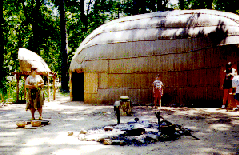

The land near the Chesapeake Bay and the inlets and rivers which flow into it is called 'Tidewater' country. Ashley and Megan have done a little research on our Tidewater Indians. Almost all the Indian tribes in Maryland belonged to the Algonquin nation. Many of the names of cities and counties in our region are Indian names of tribes within the Algonquin nation. We live in Wicomico County and I travel to school each day on Nanticoke Road. These are names of Indian tribes who lived on our peninsula. These Native Americans settled in our area several hundred years before the Europeans came. Other Indians lived here thousands of years before the Algonquins.
Indian Houses
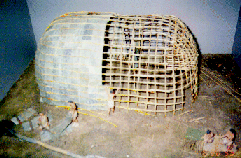 They used trees made into poles as the frame of the house.
They dug holes to put the big end of the pole into. After
that they filled the rest of the hole with dirt. Then they
bent the top of the poles and tied them together. The
INDIAN houses were often built under trees so the hot sun of
the summer and the cold snow of the winter was kept off by
the big trees. The roof of the house was curved into an arch.
Vines, roots, and strips of bark were used for string to tie
things on the house. They had a hole in the roof that used
as a chimney for the fire they built inside. The Indians in
the houses were always warm and dry during the cold winters.
They used trees made into poles as the frame of the house.
They dug holes to put the big end of the pole into. After
that they filled the rest of the hole with dirt. Then they
bent the top of the poles and tied them together. The
INDIAN houses were often built under trees so the hot sun of
the summer and the cold snow of the winter was kept off by
the big trees. The roof of the house was curved into an arch.
Vines, roots, and strips of bark were used for string to tie
things on the house. They had a hole in the roof that used
as a chimney for the fire they built inside. The Indians in
the houses were always warm and dry during the cold winters.
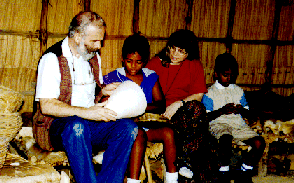 There is also another kind of tribe that moved around
with their homes because they had to move where their food
moves so they have something to eat because they did not know
how to grow food. So that is why they had to hunt food.
Since those hunting houses were small only a few people could
sleep in them.
There is also another kind of tribe that moved around
with their homes because they had to move where their food
moves so they have something to eat because they did not know
how to grow food. So that is why they had to hunt food.
Since those hunting houses were small only a few people could
sleep in them.
By Megan
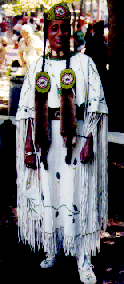 Clothing
Clothing
In the summer the Indians of Tidewater country wore very little clothes. The children wore almost nothing. Around their waist the men and women wore something like an apron. Most the time they would decorate them with beads and fringe.
In the winter the Indians would rap up in a long cloak like thing. They also wore leggings and moccasins to keep their legs warm.
The Algonquins made most of their clothes from animal skins. Most the time the skin was deer skin. They scraped the fur off of the skin from the summer clothes. They didn't take the fur from the winter clothes because those clothes were the most important. Most of the leaders wore cloak. A lot of the Indians wore moccasins. They were either woven from tree bark or they were woven from skins.
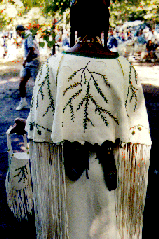
Indians wore things like pocketbooks or a kind of bag. In the bags the Indians had knives, tobacco, pipes, and arrow stones. They would fasten things to their bags. The bags were usually made of deer skin. The Indians put beads and fringe on them.
The Indians didn't have needles so the would use a sharp point bone. For their thread they used a thin but strong cord from the leash of animals.
For decoration they would put beads on their clothing. Sometimes they would wear bracelets or a necklace. The Indians would poke holes into shells and decorate like beads. Sometimes they would put ornaments like eagle claws or rattlesnake beads, and many other things on their clothing.
Sometimes the men and women would wear turkey feathers in their hair. Most of the time the chief would wear a flattened piece of copper on their forehead.
Ashley
Photos of Indian houses on this page were taken at the Jamestown Settlement in Virginia. Mike Burleigh is seated in the wigwam or longhouse with me and Dr. Mano Talaiver's two sons, Joseph and David. During Mike's visit to Maryland in August we visited Mano and Manual Talaiver in Richmond, Virginia who showed us wonderful Southern hospitality. Thank you, Mano, Manual and boys! The photo of the Indian woman was taken at the Nanticoke Pow Wow in Delaware.